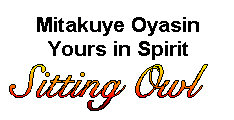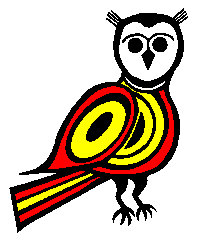|
Main
Menu
External
Pages
|
Sitting Owl’s Book Review
‘The Spiral Dance’
A Rebirth of the Ancient Religion
Of the Great Goddess
By: STARHAWK
As the name of this book implies, it is about the dance of life, and as the subtitle suggests, it is about the view of life from the female’s perspective. But what it doesn’t fully imply is that it is mostly about Witchcraft.
For many people this fact could either cause a reaction of dread and fear, or in others; “finally some female power”. However, I found it to contain some helpful information about most of the ancient understandings of life and the nature of Spirit and Psychology, and after all, the ancient witches were in fact shamans.
Here are my two favourite pieces from the chapter ‘The World View of Witchcraft’:
“In the Faery Tradition of Witchcraft, the unconscious mind is called the Younger Self; the conscious mind is called Talking Self. Because they function through different modes of awareness, communication between the two is difficult. It is as if they speak different languages.
“It is Younger Self that directly experiences the world, through the holistic awareness of the [right] hemisphere [of the brain – Ed]. Sensations, emotions, basic drives, image memory, intuition and diffuse perception are functions of Younger Self, which corresponds roughly to Freud’s concept of the id, to the personal and collective unconscious described by Jung, and to the “Child” mode of Transactional Analysis. Younger Self’s verbal understanding is limited; it communicates through images, emotions, sensations, dreams, visions, and physical symptoms [Cellular memory].
Classical psychoanalysis developed from attempts to interpret the speech of Younger Self. Witchcraft not only interprets, but also teaches us how to speak back to Younger Self.
“Talking Self organises the impressions of Younger Self, gives them names, classifies them into systems. As the name implies, it functions through the verbal, analytic awareness of the left hemisphere and can be compared to the concept of "ego” in both Jungian and Freudian psychology,… Talking Self speaks through words, abstract concepts, and numbers.
“In the Faery tradition, a third “self” is recognised: the High Self or God Self, which does not easily correspond to any psychological concept. [I believe Jung referred to this as the “Self” and “Universal Unconscious” as apposed to “self” as ego.] The High Self is the Divine within, the ultimate and original essence, and the spirit that exists beyond time, space, and matter. It is our deepest level of wisdom and compassion and is conceived of as both male and female, two motes [modes?] of consciousness united as one. It is often symbolised as two linked spirals, or as the infinity sign, the 8 on its side…
“The creation myth that heads this chapter clearly expresses the attitude of wonder, to the world, which is divine, and to the divine, which is the world.
In the beginning, the Goddess is the All, virgin, meaning complete within Herself. Although She is Goddess, She could just as easily be called God – sex has not yet come into being. As yet there is no separation, no division, nothing but the primal unity. Yet the female nature of the ground of being is stressed – because the process of creation that is about to occur is a birth process. The world is born, not made, and not commanded into being.
“The Goddess sees her reflection in the curved mirror of space, which may be a magical insight into the form of the universe, the curved space of modern physics.
The mirror is an ancient attribute of the Goddess, according to Robert Graves, in her aspect as “the ancient pagan Sea Goddess Marian… Miriam, Mariamne (Sea Lamb),
Myrrhine, Myrtea, Myrrha, Maria, Marina, patroness of poets and lovers and proud mother of the Archer of Love… the mirror did also form part of the sacred furniture of the Mysteries, and probably stood for ‘Know thyself.’ “
“Water is the original mirror, the image conveyed is also that of the moon floating over the dark sea, watching her reflection in the waves. A faint echo can be heard in the opening of Genesis: “The earth was unformed and void, and the spirit of God floated on the face of the water.”
“There is yet another aspect to the mirror: A mirror image is a reversed image, the same, but opposite, the reverse polarity. The image expresses the paradox: All things are one, yet each thing is separate, individual, and unique… We are all “swirls” of the same energy, yet each swirl is unique in its own form and pattern.
“The Goddess falls in love with Herself, drawing forth her own emanation, which takes on a life of its own. Love of self for self is the creative force of the universe. Desire is the primal energy, and that energy is erotic: the attraction of lover to beloved, of planet to star, the lust of electron for proton. Love is the glue that holds the world together.
My only comment on this chapter is that Starhawk denies sacrifice or the suffering of life. However, I admit that this is a very touchy subject that she has handled fairly well. She quotes Joseph Campbell who goes so far as to say, “Human sacrifice… is everywhere characteristic of the worship of the Goddess”. But she says that sacrifice is not suffering. And so it shouldn’t, it should be as she says, ecstatic. And yet, in the chapter on initiation, she quotes a part of the ritual thus: “ “Are you willing to suffer to learn?” She is asked, because learning, and growth, always involve pain.” And that statement is all too true!
At the end of the book Starhawk gives tables of correspondences which link the elements with the associated direction, time of day, season etc., and I found that what was familiar to me was pretty much the same as the Medicine Wheel, for the Northern Hemisphere. However, it seemed that perhaps somewhere in the evolution of the craft, someone has decided that creation, and all things, begin with air, not fire, so as a result the elements have been rotated one quarter of a turn in relation to most of everything else. I’m not willing to judge here, but this may or may not, have something to do with some problems that the author admits to occurring within covens of the craft.
Regarding spells, Starhawk says:
“A spell is a symbolic act done in an altered state of consciousness, in order to cause a desired change. To cast a spell is to project energy through a symbol. But the symbols are too often mistaken for the spell. “Burn a green candle to attract money,” we are told. The candle itself however does nothing – it is merely a lens, an object of focus, a mnemonic device, and the “thing” that embodies our idea. Props may be useful, but it is the mind that works magic.”
 
Donations
If you would like to make a donation to Sitting Owl
please use this button.
|